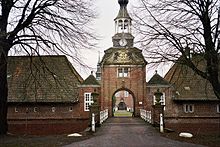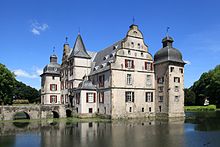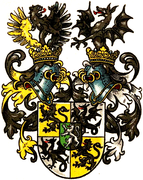Innhausen and Knyphausen
Innhausen and Knyphausen , abbreviated Inn- und Knyphausen , often just Knyphausen or Kniphausen , is the name of an old Frisian chief family . The family, some of which still exist today, belongs to the East Frisian nobility .
history
origin
The sex was like all the Frisian nobility noble free , or at least free origin. The uninterrupted line of trunks begins with the Grote Onneken who was born around 1350 . He died before April 6, 1409 (probably on August 24, 1405) as a chief in Sengwarden (now part of Wilhelmshaven ). The village is mentioned for the first time in 1168 and was an independent glory during the Middle Ages .
Spread and personalities
Heir to the Tiarksena in Innhausen
Iko, the younger son of the progenitor Grote Onneken, married a granddaughter of Ino Tiarksena, around 1350 judge of Östringen and alleged builder of Innhausen Castle (also Inhausen ), namely Hilleda Tiarksena, daughter and heiress of Popko you , chief of Innhausen. The castle was the center of the lordship that encompassed the parish of Sengwarden . Iko died in 1454, succeeding his father-in-law, as chief of Innhausen. From his third marriage to Tetta von Raffhusen, Alko der Böse came from (documented evidence 1447–1474), also chief of Innhausen. His son Folef (also Fulf) Alksen (around 1465–1530 / 31) received in 1496 by inheritance from his cousin the imperial rule Kniphausen with Kniphausen Castle and united both dominions as chiefs of Inn and Knyphausen. Folef was married to Hyma Bindelef Beninga , daughter of Ubbo Beninga zu Upleward and Hebrich Beninga zu Grimersum . He was a loyal supporter and advisor to Count Edzard the Great of East Friesland. The rule now included the parishes of Accum , Sengwarden and Fedderwarden and thus an area of about 45 km².
Lordship of Inn- and Knyphausen
The rule Inn- and Knyphausen went to the son of Folef, Tido Folefsen (1500–1565), an opponent of Maria von Jever . He married Countess Eva von Rennenberg , daughter of Count Wilhelm von Rennenberg and Countess Cornelia von Cuylenburg . Tido built the Klunderburg, was chief of Inn- and Knyphausen and district administrator. In 1547 he lost the rule of Inn- and Kniephausen to the rule of Jever . After brief recovery the rule was 1623/1624 in a trial before the Imperial Court in Speyer finally to the counts of Oldenburg assigned. Tido's grandson Philipp Wilhelm von Innhausen and Knyphausen (1591–1652), who expressly reserved the continuation of the title of Baron of Innhausen and Knyphausen, made the settlement before the Imperial Court of Justice with Count Anton Günther von Oldenburg . An annual pension was also agreed, which was paid out 340 years later until a transfer agreement with the state of Lower Saxony in 1964.
Heir of the Manninga zu Lütetsburg
Philip William Uncle Wilhelm (1557-1631), since 1588 baron to Innhausen and Knyphausen, married Hyma, the heiress of the Unico Manninga , the last chief of this old East Frisian dynastic , the builders of Manningaburg in Pewsum. Wilhelm, on Visquard , Jennelt and Upleward, Drost to the north , received in 1581, according Testament his father Unico Manninga that the primogeniture appointed glory Lützburg ( Lütetsburg ). A Fideikommiss was donated from this property in 1584 . His sons, including Dodo (* 1583; killed in the Battle of Haselünne in 1636), royal Swedish field marshal during the Thirty Years' War , Herr auf Jennelt and Weissen-Klempenow near Stargard , Lord of the Emsland , were given the status of barons in 1635 with the provision that the respective Majoratsherr of the rule Lütetsburg was allowed to carry the title Noble Lord to Lütetsburg and Bergum . Since November 16, 1867, the owner of the entails was also a hereditary member of the Prussian manor house .
After the Thirty Years War
Dodo's son Enno Adam (1611–1654), on Jennelt and Weissen-Klempenow, was also a colonel in royal Swedish, but also in Dutch military services. His wife Occa Johanna Freiinvon Ripperda was married in 1656 to the Swedish Imperial Council , Governor General and Reichszeugmeister Erik Graf Stenbock (* 1611), who fell before Copenhagen in 1659 . She was the chief stewardess of Queen Hedwig Eleonora of Sweden . Enno and Occa's descendants gained further ownership and reputation in Kurbrandenburg . Dodo (1641–1698), one of the sons, Majoratsherr auf Lütetsburg and Jennelt, was a princely East Frisian court judge and became a Real Privy Councilor of Brandenburg , President of the Chamber and Minister of State . He was married to Hedwig Oriana Freiin von Frydag . Both the younger son Friedrich Ernst Freiherr zu Innhausen and Knyphausen became royal Prussian secret minister of state . The older son, Franz Ferdinand Freiherr zu Innhausen and Knyphausen (1673–1725), Majorate Lord on Lütetsburg and Bergum, was President of the East Frisian Knighthood. He married in Berlin in 1706 Sophie Luise von Tettau , daughter of the royal Prussian lieutenant general and chamberlain , governor of Spandau and commander of the Gardes du Corps , Johann Georg von Tettau on Wolienen, etc. The eldest son, Karl Philipp (1711–1784), majorate Lütetsburg, Jennelt and Bergum, also President of the East Frisian Knighthood, was with Sophie Charlotte Baroness Wedel-Jarlsberg , daughter of the royal Danish Privy Councilor and Lieutenant General Erhard Baron Wedel-Jarlsberg, Majorate Lord on glory Evenburg , and Countess Marie Juliane von Frydag, heiress of Glory of Godens , married. The sons Edzard Mauritz (1748–1824) and Karl Gustav (1749–1841), donors of the two main lines, came from the marriage of Karl Philipps with Sophie Charlotte .
Older Main Line (Older and Younger Branch)
Edzard Mauritz in turn had two sons Carl (1784-1860) and Franz (1792-1875). After the Congress of Vienna in 1815 and the incorporation of East Frisia into the Kingdom of Hanover , Carl Graf zu Innhausen and Knyphausen received on April 25, 1834, on the basis of the majorate donated by his ancestor, the chief Unico Manninga, a hereditary virile vote in the first chamber of the General Assembly of Estates of the Kingdom of Hanover . Carl Graf zu Innhausen and Knyphausen († 1860) became Royal Hanoverian Real Privy Councilor, Chamberlain, Envoy and Minister Plenipotentiary at the royal Prussian and Saxon courts. From his marriage to Luise Countess von Kielmansegg , daughter of Friedrich Graf von Kielmannsegg , royal Hanoverian general of the infantry , Edzard Graf zu Innhausen and Knyphausen (1827-1908) emerged, who was royal Hanoverian chamberlain and district administrator of the Principality of East Friesland. He was majorate ruler of Lütetsburg and owner of the Visquard estate and the Nienhagen free farm . His wife inherited the Krassow Fideikommiss Pansevitz on Rügen . Edzard was raised to the Prussian prince's status on New Year 1900 and is thus the founder of the princely branch, while his uncle Franz (1792–1875), Fideikommissherr on Jennelt and Arle , royal Hanoverian appellate judge, extraordinary member of the state council and president of the estates of the principality Ostfriesland, founded the purely counts branch of the sex.
The third and last Prince of Innhausen and Knyphausen was the unmarried Wilhelm Edzard (* 1908), who died on 7 August 1978 in his holiday home in Terre di Pedemonte in Ticino in southern Switzerland as a result of the extreme floods of the Melezza . In 1961 he had adopted Moritz Freiherr zu Innhausen and Knyphausen (* 1948) from the Count's house of Bodelschwingh-Plettenberg as Count of Innhausen and Knyphausen. Furthermore, in 1972 he adopted his nephew and niece, Christian von Plessen (* 1939), Doda von Plessen (1941, married Hansen) and Occa von Plessen (* 1942, married von Reden) , children of his sister Hilleda nee. Countess of Innhausen and Knyphausen (1912–1945) and Bernhard von Plessen (1908–2003) of Damshagen and Schönfeld.
Huberta Countess zu Innhausen und Knyphausen (1942–2011), daughter of Karl-Theodor Graf zu Innhausen and Knyphausen (1910–1942) on Pansevitz , Rügen Island, niece of the last and granddaughter of the second prince, Dodo (1876 ) came from the princely line –1931), who had been married to the lawyer Jörg von Hugo (1940–2004) since 1968, who, according to Section 1355 of the German Civil Code (BGB ), had been named Hugo-Graf zu Innhausen and Knyphausen since 1979. The children from the marriage, Tido, Alvo and Theda, bear the name Graf and Countess zu Innhausen and Knyphausen. The family lives in Lütetsburg Castle . Tido Graf zu Inn- und Knyphausen (* 1972) is managing director and general administrator of the Count's Rent Office Lütetsburg and managing director of the golf course Schloss Lütetsburg. He has been married to Margareta von Strantz (* 1977) since 2003 , with whom he has three sons and a daughter. His brother Alvo Graf zu Inn- und Knyphausen (* 1975) is a member of the board of the Schlosspark Pansevitz Foundation and is married to Fabia Wegener (* 1977), with whom he has two sons.
Younger main line (older and younger branch)
The younger main line, founded by Karl Gustav Freiherr zu Innhausen and Knyphausen (1749–1841), royal Prussian chamberlain, had owned Jennelt and the Arle estate through him until the middle of the 19th century. She then ceded this property to the count's (younger) branch of the older main line. Karl Gustav had the two sons Moritz (1795-1854), the progenitor of the older Astes Bodelschwingh-Plettenberg, who was later count in Primogenitur , and Wilhelm (1797-1863), a royal Prussian lieutenant a. D., legal knight of the Order of St. John , ancestor of the younger, purely baronial branch. The older Ast also owned the Gut Erstes Haus Leer and the Klostergut Thedinga (temporarily as Fideikommiss Leer-Thedinga) in East Friesland and the goods Geiglitz in West Pomerania, Görlitz in East Prussia and Kalittken in the Rosenberg district in West Prussia, which were expropriated in 1945 .
Moritz Freiherr zu Innhausen and Knyphausen (1795–1854), Drost zu Esens and royal Prussian Colonel a. D., Knight of Honor of the Order of St. John. From his first marriage to Maria Countess von Haeseler († 1840) came Dodo Alexander Moritz Freiherr zu Innhausen and Knyphausen, later also Count von Bodelschwingh-Plettenberg (1835–1911), royal Prussian major and chamberlain and Fideikommissherr on Leer-Thedinga. Through his marriage to Wilhelmine von Bodelschwingh-Plettenberg, daughter of Count Carl von Bodelschwingh-Plettenberg , Haus Bodelschwingh came into the family, as did the neighboring Haus Rodenberg and the Draiser Hof in the Rheingau (today the Baron Knyphausen winery ). His son Karl Moritz Freiherr zu Innhausen and Knyphausen, Count von Bodelschwingh-Plettenberg (1871–1958), was entrant on Bodelschwingh . His son Edzard (1905–1983), from Bodelschwingh etc., farmer and like his father legal knight of the Order of St. John, was the last bearer of the primogeneity title or name Graf von Bodelschwingh-Plettenberg, his children all bear the same name Freiherr or Freiin to Innhausen and Knyphausen; the son of his cousin Dodo, Moritz (* 1948), is, however, an adopted son of Wilhelm Edzard Fürst zu Innhausen and Knyphausen († 1978) from the older main line, and therefore bears the name Graf zu Innhausen and Knyphausen.
Baronial Dutch line
The Dutch line received Dutch nobility in 1814 and died out in 1884. This branch line has its origin in Enno Wilhelm von Innhausen and Knyphausen (* March 28, 1586, † November 16, 1656) the younger brother of Dodo von Knyphausen . Enno Wilhelm was a colonel and commandant of Hamburg. In 1617 he married Anna Maria von Amelunxen († 1657) from the Geßmühl family. His son Rudolph Wilhelm (* 1620; † November 30, 1666) studied law in Groningen and became the diplomatic representative of the States General . He married Margareths Beata von Fridagh-Loringhoff (1621-1665). Their son Haro Caspar (1646–1694) married the heiress Petronella Anna Lewe (1648–1686 ) in 1663 and received the Ulrum estate near Groningen, where his family lived from then on and he also died. The couple had several children, the family line was continued by Hendrik Ferdinand (1666-1716), who married Aurelia ave Jarges (1666-1702) in 1693 . Their son Haro Caspar (1698–1741) was a Dutch military man and married Petronella Anna Lewe (1702–1771). Their son Ferdinand Folef (* June 7, 1736; † May 12, 1796) married Anna Maria Graafland (1743-1803) in 1768 and continued the family line. His son Haro Caspar (May 4, 1777 - January 3, 1842) married Susanna Elisabeth Alberda Bijma (from Bloemersma) (November 4, 1769 - December 30, 1836). His son Ferdinand Folef (* May 4, 1804, † November 23, 1884) was known as “de dolle jonker” (the crazy baron). He became mayor of Leek and Marum . The line ended with him.
Status surveys

Iko and Wilhelm zu Innhausen and Knyphausen, lords of Lütetsburg, were raised to the imperial baron status of Prague on June 14, 1588 as barons to parents and Vogelsang, Erbmeier to Bastenach (Bastenack). On September 19, 1635, the Tido brothers, Countess East Frisian privy councilor and president, Enno Wilhelm, colonel and commander of the Hanseatic city of Hamburg , and Carl Friedrich zu Innhausen and Knyphausen also received the imperial baron status as noble lord zu Lütetsburg and Bergum . On July 17, 1671, the brothers Dodo and Moritz zu Innhausen and Knyphausen received confirmation of the imperial baron status with the address Well-born .
Georg Wilhelm zu Innhausen and Knyphausen, Freiherr zu Eltern and Vogelsang, State Councilor of the Estates of the United Netherlands and President of the East Frisian Knighthood, was raised to the rank of imperial count in Vienna on March 9, 1694, with the salutation high and well-born and an increase in coat of arms . With the death of his son Carl Wilhelm, this imperial count's branch became extinct.
From the older line received on March 5, 1816, published on July 23, 1816 at Carlton House , Edzard Mauritz Freiherr zu Inn- und Knyphausen (1748-1824), royal Hanoverian president of the East Frisian Chamber, the Hanoverian count. His grandson Edzard Graf zu Innhausen and Knyphausen, noble lord of Lütetsburg and Bergum (1827-1908), royal Prussian Real Privy Councilor and hereditary member of the Prussian mansion, was raised to the Prussian prince's status in Berlin on January 1, 1900, with the salutation Serene Highness . The title was in primogenitur and tied to the property of the Fideikommiss Lütetsburg and Bergum. The later born carried the title Graf or Countess to Innhausen and Knyphausen.
From the younger line came Dodo Freiherr zu Innhausen and Knyphausen (1835–1911), Fideikommissherr on Leer-Thedinga, royal Prussian chamberlain and major . After his marriage to Minette Freiin von Bodelschwingh-Plettenberg , Fideikommissherrin on Bodelschwingh, he received a Prussian name association with the Barons von Bodelschwingh-Plettenberg as baron on February 17, 1908 in Berlin by means of the highest cabinet order and by diploma of May 15, 1908 in Wiesbaden to Innhausen and Knyphausen from Bodelschwingh-Plettenberg. The title was linked to the possession of the Fideikommiss Bodelschwingh. On August 5, 1909 in Swinoujscie he was raised to the Prussian count status by the highest cabinet order as Baron of Innhausen and Knyphausen, Count of Bodelschwingh-Plettenberg (diploma issued on August 10, 1909 in Hohensyburg ). The title was tied to the possession of Fideikommiss Bodelschwingh.
Moritz Freiherr zu Innhausen und Knyphausen (* 1948) from the Counts' House of Bodelschwingh-Plettenberg received a non-objection under nobility law as Count zu Innhausen and Knyphausen on October 21, 1963 in Marburg an der Lahn by resolution of the committee for nobility law issues of the German nobility associations . He has been the adopted son of Wilhelm Edzard Fürst zu Innhausen and Knyphausen (1908–1978) since 1961.
coat of arms
Family coat of arms
The family coat of arms shows a black lion in gold . On the helmet with red and gold covers a growing black lion between two golden wings . According to the Genealogical Handbook of the Nobility, the helmet covers are black and gold and the wings are gold on the right and black on the left.
Because of the Kniphausen rule, the family arms of Innhausen and Knyphausen appear in the state coat of arms of the Grand Duchy of Oldenburg (field 6).
Baron and Count's coat of arms
The baronial coat of arms, awarded in 1588, is quartered and covered with a middle shield split by green and black , inside a crowned silver lion (coat of arms of the extinct Manninga ). 1 and 4 the family coat of arms, 2 and 3 in silver a black dragon with spread wings and a gold neck ring (coat of arms of the extinct Beninga in Upleward ). The coat of arms has three helmets, on the right the trunk helmet, on the middle one with green-silver covers a golden pelican with cubs in the nest and seven (four to the right and three to the left) flying flags on golden poles, divided by green and black (helmet of the Manninga ), on the left helmet with black and silver covers the dragon (helmet of the Beninga zu Upleward).
Two opposing gold-armored black griffins serve as a shield holder . The motto is: Veritas vincit ( Latin for truth wins). The later count's coat of arms looks the same.
Historical coats of arms
Family coat of arms of Otto Hupp in the Munich calendar of 1902
family members
- Alko der Böse or Alko Onneken (documented mention since 1447; † 1474), chief of Innhausen
- Carl Philipp zu Innhausen and Knyphausen (* 1711; † 1784), East Frisian nobleman
- Dodo zu Innhausen and Knyphausen (* 1583; † 1636), important general in the Thirty Years War
- Dodo (II.) Zu Innhausen and Knyphausen (* 1641; † 1698), Brandenburg statesman
- Dodo Heinrich zu Innhausen and Knyphausen (* 1729; † 1789), Prussian diplomat
- Dodo Prince of Innhausen and Knyphausen (* 1876 † 1931), German landowner and parliamentarian
- Dodo zu Innhausen and Knyphausen (District Administrator) (* 1877 † 1967), German manor owner and administrative officer
- Edzard Freiherr von Inn- und Knyphausen (Edzard Friedrich Ludwig, Prince of Innhausen and Knyphausen, * 1827, † 1908), East Frisian nobleman and politician
- Edzard Moritz zu Innhausen and Knyphausen (* 1748; † 1824), President of the East Frisian Landscape
- Felix zu Knyphausen (* 1969), German actor
- Friedrich Ernst zu Innhausen and Knyphausen (* 1678; † 1731), Brandenburg-Prussian Chamberlain and Minister of the Lower Rhine-Westphalian Empire
- Gisbert zu Knyphausen (* 1979), German songwriter, singer and guitarist
- Karl Wilhelm zu Innhausen and Knyphausen (* 1784; † 1860), Hanoverian chief diplomat in Berlin (1844-1860)
- Philipp Wilhelm von Innhausen and Knyphausen (* 1591; † 1652), German local politician
- Rudolf Wilhelm zu Innhausen and Knyphausen (* 1620; † 1666), Dutch diplomat
- Wilhelm zu Innhausen and Knyphausen (* 1716; † 1800), Hesse-Kassel general in the American War of Independence
Individual evidence
- ↑ The Frisian nobility was spared the "Franconian" feudal system, see Frisian freedom . The possessions were mostly allod and not fiefs of a more powerful landlord, for example a bishop or count, to whom they should have submitted.
- ↑ a b c d e f g Genealogisches Handbuch des Adels , Adelslexikon Volume V, Volume 84 of the complete series, pages 462–464
- ^ Ernst Friedländer : Ostfriesisches Urkundenbuch I. Nr. 216; Emden 1878
- ↑ www.wilhelmshaven.de
- ↑ a b Gerhard Köbler : Historical Lexicon of the German Lands. The German territories from the Middle Ages to the present. 7th, completely revised edition. CH Beck, Munich 2007, ISBN 978-3-406-54986-1 , pp. 310 and 339.
- ↑ a b c New General German Adels Lexicon Volume 5, Pages 170–172
- ↑ a b c Otto Hupp : Munich Calendar 1902. Page 28
- ↑ 1978: l'anno della grande alluvione , Losoneè June 2018, p. 14
- ^ Genealogisches Handbuch des Adels, Adelige Häuser A Volume XXI, Pages 300-301, Volume 98 of the complete series, CA Starke Verlag, Limburg (Lahn), 1990
- ^ Genealogical handbook of the nobility, Adelige Häuser B Volume XXI, Volume 108 of the complete series, Limburg / Lahn 1995, p. 187 f.
- ↑ Homepage Golf Club Lütetsburg
- ^ Homepage Rentamt Lütetsburg
- ^ The Heirs of Europe: Innhausen and Knyphausen
- ↑ Homepage of the Pansevitz Castle Park Foundation
- ^ Obituary notice Huberta Countess zu Innhausen and Knyphausen
- ^ Catalog of the German National Library
- ^ Genealogical handbook of the nobility, Freiherrliche Häuser A Volume III, Volume 21 of the complete series, Limburg / Lahn 1959
- ^ Genealogical handbook of the nobility, Gräfliche Häuser A Volume IV, Volume 28 of the complete series, Limburg / Lahn 1962, p. 224
- ^ Genealogical handbook of the nobility, Princely Houses Volume V and Volume XI, Volume 75 of the complete series, Limburg / L. 1980, Department III A
literature
- Udo von Alvensleben: The Lütetsburger Chronik - history of a Frisian chief dynasty. Wallstein-Verlag, Göttingen 1988; ISBN 3-89244-005-0
- Otto Hupp : Munich calendar 1902. Book a. Art Print AG, Munich / Regensburg 1902.
- Ernst Heinrich Kneschke : New general German nobility lexicon . Volume 5, Friedrich Voigt's Buchhandlung, Leipzig 1864, pages 170–172. ( Digitized version )
- Günther Möhlmann: Knyphausen, zu Innhausen and (East Frisian chief and aristocratic family). In: New German Biography (NDB). Volume 12, Duncker & Humblot, Berlin 1980, ISBN 3-428-00193-1 , p. 233 f. ( Digitized version ).
- Hugo Stockter: Three women fighting for Kniphausen. Kniphausen Castle Foundation, Wilhelmshaven 1994; ISBN 3-930510-52-9
- Leopold von Zedlitz-Neukirch : New Prussian Adelslexicon . Vol. 3, Gebrüder Reichenbach, Leipzig 1837, pp. 35-36. ( Digitized version )
- Genealogisches Handbuch des Adels , Adelslexikon Volume V, Volume 84 of the complete series, pages 462–464; CA Starke Verlag, Limburg (Lahn) 1984 ISSN 0435-2408
- Genealogical paperback of the German count's houses 1843 S.285f , 1847 S.336f , 1856 S.380f , 1869 S.445f
- Johann Wilhelm Franz von Krohne , General German Adels Lexicon , p.193ff
Web links
- Coats of arms of those at Innhausen and Knyphausen (here as Kniphausen) in volume 5 of Johann Siebmacher's book of arms in 5 volumes (1705)
- Coat of arms of the barons of Innhausen and Knyphausen in the register of arms of the Westphalian nobility
- Entry about Innhausen and Knyphausen, barons, counts and princes from (15th – 20th centuries) in the central database of bequests
- Enno Wilhelm von Innhausen and Knyphausen and descendants
- Haro Casper von Inn- and Kniphausen (1777-1842)










